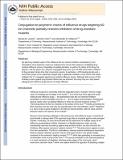Conjugation to polymeric chains of influenza drugs targeting M2 ion channels partially restores inhibition of drug-resistant mutants
Author(s)
Larson, Alyssa Maxine; Chen, Jianzhu; Klibanov, Alexander M.
DownloadKlibanov_Conjugation to.pdf (1.376Mb)
OPEN_ACCESS_POLICY
Open Access Policy
Creative Commons Attribution-Noncommercial-Share Alike
Terms of use
Metadata
Show full item recordAbstract
By attaching multiple copies of the influenza M2 ion channel inhibitors amantadine (1) and rimantadine (2) to polymeric chains, we endeavored to recover their potency in inhibiting drug-resistant influenza viruses. Depending on loading densities, as well as the nature of the drug, the polymer, and the spacer arm, polymer-conjugated drugs were up to 30-fold more potent inhibitors of drug-resistant strains than their monomeric parents. In particular, a 20% loading density and a short linker group on the negatively charged poly-l-glutamate resulted in one of the most potent inhibitors for 2's conjugates against drug-resistant influenza strains. Although full recovery of the inhibitory action against drug-resistant strains was not achieved, this study may be a step toward salvaging anti-influenza drugs that are no longer effective.
Date issued
2013-07Department
Massachusetts Institute of Technology. Department of Biological Engineering; Massachusetts Institute of Technology. Department of Biology; Massachusetts Institute of Technology. Department of Chemistry; Koch Institute for Integrative Cancer Research at MITJournal
Journal of Pharmaceutical Sciences
Publisher
Wiley Blackwell
Citation
Larson, Alyssa M., Jianzhu Chen, and Alexander M. Klibanov. “Conjugation to Polymeric Chains of Influenza Drugs Targeting M2 Ion Channels Partially Restores Inhibition of Drug-Resistant Mutants.” J. Pharm. Sci. 102, no. 8 (July 6, 2013): 2450–2459.
Version: Author's final manuscript
ISSN
00223549
1520-6017